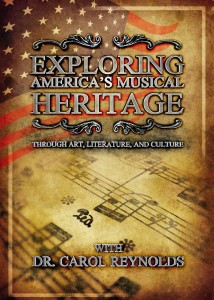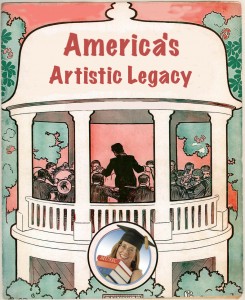A reader asked me to compare our 2011 Exploring America’s Musical Heritage program (2 DVDs) with the on-line course America’s Artistic Legacy. In terms of chronological scope, both programs cover approximately the same time period: 1600 to c. 1950. Beyond that, they are quite different programs.
Exploring America’s Musical Heritage
 The 2 DVD set emphasizes American music as well as art, architecture, literature, dance, and, of course, historical and cultural information. It is very rich, visually, and shot fully on location. I teach the course (from a 1930s one-room school-house) and am joined in a variety of scenes by 38 artists, specialists, historians, and commentators. These people contribute a great deal to the program. To give you some idea, you’ll hear from people as varied as the head miller of George Washington’s Grist Mill at Mt. Vernon, the official historian at West Point, and a Louisiana engineer who makes Cajun accordions.
The 2 DVD set emphasizes American music as well as art, architecture, literature, dance, and, of course, historical and cultural information. It is very rich, visually, and shot fully on location. I teach the course (from a 1930s one-room school-house) and am joined in a variety of scenes by 38 artists, specialists, historians, and commentators. These people contribute a great deal to the program. To give you some idea, you’ll hear from people as varied as the head miller of George Washington’s Grist Mill at Mt. Vernon, the official historian at West Point, and a Louisiana engineer who makes Cajun accordions.
We designed this program to serve several audiences: middle-schoolers who would be focusing on American history; family members of all ages who can use the units as part of their general educational enrichment; and high-schoolers who might use the program to enrich a high school-level American history course.
You’ll find on the web here a unit-by-unit study guide that accompanies each of the eight units. In terms of academic level, the material is appropriate for middle schoolers/upper elementary, but can be adapted to a higher (or younger) level. There is no testing mechanism. Exploring America’s Musical Heritage comes in physical format (DVDs) with the on-line study materials available free at my website.
America’s Artistic Legacy
 This course is designed as a solid course for high-school credit. It covers approximately 1600 to 1950 and is equally strong on music, art, architecture, literature, and dance, with strong focus on cultural, political, even military history. I teach the course in formal video sessions (webinars), richly illustrated with art, graphs, maps, as well as cut-away video sequences filmed on location across the U.S.
This course is designed as a solid course for high-school credit. It covers approximately 1600 to 1950 and is equally strong on music, art, architecture, literature, and dance, with strong focus on cultural, political, even military history. I teach the course in formal video sessions (webinars), richly illustrated with art, graphs, maps, as well as cut-away video sequences filmed on location across the U.S.
The assignments are substantial, vivid, and quite engaging. Assignments expand the class material and delve more deeply into history, politics, culture, as well as the arts. They link to interesting material, including performances and documentary clips of historical interest. There are self-grading quizzes as well.
America’s Artistic Legacy is designed as a stand-alone course or it can be used in conjunction with traditional American history texts. It exists solely in an on-line format as part of our Circle of Scholars.
Overlap?
In terms of “overlap” between the two programs, they both cover the same time period: 1600-c. 1950. There are some common video sequences and topics in both courses, but those topics are treated far more extensively in America’s Artistic Legacy. A large portion of the material in America’s Artistic Legacy will not be found in the smaller 2-DVD set, including the aforementioned assignments, testing mechanisms, and strong focus on political and social history.
Depending on the age and interest level of your students, you could choose even to do both programs, introducing the topics to younger students via Exploring America’s Musical Heritage and then turning to America’s Artistic Legacy for high-school credit. If your goal is family enrichment or study for middle-school, upper elementary, then the 2-DVD set of Exploring America’s Musical Heritage may be sufficient.



